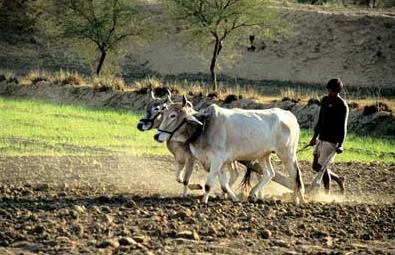Wind erosion also has been responsible for destroying the valuable top soil in many areas. Halting the march of desert in Rajasthan is one of the vital and outstanding problems facing the country today. An extreme example of sand movement from the coast is to be seen in the Saurashtra region of Gujarat where the once-flourishing ports are now covered with advancing sand-dunes.
In addition to the erosion of the cultivated fields, neglected pastures and wastelands, considerable roadside erosion also takes place owing to the defective highway engineering. Defective drainage and water-logging throw appreciable areas out of cultivation every year and indirectly increase the erosion hazards.
Extent of soil erosion. In India, there is very little area free from the hazard of soil erosion. It is estimated that out of 305.9 million hectares of reported area, 145 million hectares is in need of conservation measures.
Severe erosion occurs in the sub-humid and per-humid areas due to high rainfall and improper management of land and water.
Agricultural land in the major part of the country suffers from erosion. Apart from reducing the yields through the loss of nutrients, erosion destroys the soil resources itself every year. For example, in Maharashtra over 70 per cent of the cultivated land has been affected by erosion in varying degrees and 32 per cent of the land having been highly eroded is no longer cultivable. In the Sholapur district, nearly 17 per cent of the land of medium depth (more than 45 cm) has deteriorated into shallow soils (less than 45 cm) in 75 years from 1870 to 1945. Similarly, in Akola, Buldana and Yeotmal districts, the number of fields with less than 37.5 cm soil depth increased during the same period by 54, 16 and 8 per cent respectively. As much as 2.3 million ha is already under ravines scattered all over India. The ravines apart from ruining the soil resources for ever are a constant threat to the adjoining fertile cultivated lands.
In addition to the erosion of the cultivated fields, neglected pastures and wastelands, considerable roadside erosion also takes place owing to the defective highway engineering. Defective drainage and water-logging throw appreciable areas out of cultivation every year and indirectly increase the erosion hazards.
Extent of soil erosion. In India, there is very little area free from the hazard of soil erosion. It is estimated that out of 305.9 million hectares of reported area, 145 million hectares is in need of conservation measures.
Severe erosion occurs in the sub-humid and per-humid areas due to high rainfall and improper management of land and water.
Agricultural land in the major part of the country suffers from erosion. Apart from reducing the yields through the loss of nutrients, erosion destroys the soil resources itself every year. For example, in Maharashtra over 70 per cent of the cultivated land has been affected by erosion in varying degrees and 32 per cent of the land having been highly eroded is no longer cultivable. In the Sholapur district, nearly 17 per cent of the land of medium depth (more than 45 cm) has deteriorated into shallow soils (less than 45 cm) in 75 years from 1870 to 1945. Similarly, in Akola, Buldana and Yeotmal districts, the number of fields with less than 37.5 cm soil depth increased during the same period by 54, 16 and 8 per cent respectively. As much as 2.3 million ha is already under ravines scattered all over India. The ravines apart from ruining the soil resources for ever are a constant threat to the adjoining fertile cultivated lands.

